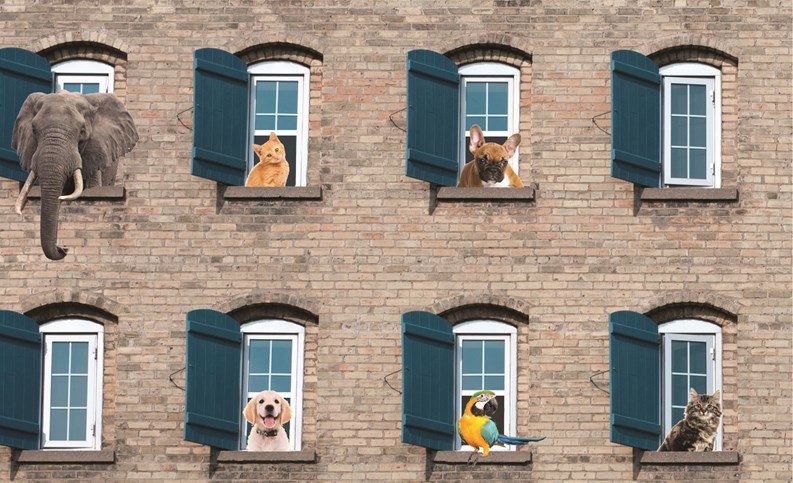Although it may sometimes feel as if our pets have the run of the land, humans are still the masters of their own domains. In order to maintain this status quo—especially in a communal environment such as a condominium, cooperative or homeowners’ association—we need to establish a set of ground rules regarding pet care, lest animals get too rich a taste of freedom and the community will literally go to the dogs.
And if you’re skeptical as to the plausibility of the latter scenario, there are other reasons yet to establish a clear pet policy in your board or association. The cleanliness of the common areas and comfort of residents are well affected by what sort of animals are allowed on the property, and how careful owners are to keep their pets in check.
The approaches to pet policies undertaken by different communities vary wildly in this day and age, from high rises that offer luxurious spa treatments for pooches to security-state communities where they test fecal matter in effort to trace a dog back to an irresponsible owner. While these are clearly extremes, there remains debate as to what approach works best, and if there are any uniform best practices that can be applied from community to community. Atop that, the increasing acceptance of therapy dogs as an aid for various disabilities calls into question the validity of long-established pet policies in communities. Amid all of this hoopla, we sought to help communities ascertain what approach would work best for their boards and associations.
Keep Your Mangy Mutt off My Lawn
While communities that have a zero-tolerance policy on pet ownership exist, they’re objectively in the minority, and quite possibly still on the decline. And even within these communities, there are often loopholes by which someone may still keep an animal on-site.
“Communities that do not permit pets still have exceptions that can be made,” says John Kadim, a property manager with Crowninshield Management Corporation in Peabody, Massachusetts. “Reasonable accommodations for individuals with service animals are almost always made. I personally have never denied a request, but I do know managers who have. These communities need to establish a set of rules and regulations for these kind of pets, similar to those rules for communities that do allow them. Both pets and their owners are required to abide by these rules as part of qualifying to live in a community with their service animal.”
The advent of the aforementioned therapy dog has created a sort of gray area in regard to the flexibility of pet-oriented regulations. “It’s very easy for someone to get a letter stating that they require a dog, and as such, it’s getting more common,” agrees Jim Stoller, president of The Building Group, a property management firm in Chicago, Illinois. “We’re seeing buildings that were formerly no dog/no pet properties now allowing animals which, in some cases, completely violates the association’s rules as they were written, and this is causing a higher degree of frustration from people who moved into those properties specifically because of the no-pet policies and want to limit pet ownership but feel powerless to do so.”
“Most developers initially make a property open to pets, as their goal is to sell units,” Stoller continues. “Many pet restrictions come in after unit owners-settle in and set limits, but we’re seeing those limits get watered down, and we have cases where residents board elevators and say they’re scared of various animals waiting therein with their owners. We also have instances where pets are restricted to, say, a service elevator, but a unit owner with a therapy pet feels as if they have the right to take communal elevators or traipse through common areas in the building, even if there is a pet restriction prohibiting them from going through the lobby. They feel as if the restrictions that have been enacted do not apply to them; that they have a superior standing in relationship to the association.”
Stoller says that, in the near future, lawsuits will emerge that will determine what is the extent that a therapy animal can violate an association’s rules and regulations. Courts will be forced to decide what gets preference: the rights of the individual or those of the community as a whole.
There Will Be Pets
Turning focus toward boards and associations that do permit pets—which more likely than not describes your humble little community—rules are best served to keep the property pristine while giving owners the freedom to enjoy their animal companions. The hardest thing for co-op board or a condo association is often not establishing adequate policy, but enforcing it.
“There are some communities wherein people abide by the rules and show respect for each other, and it’s not too difficult to keep them in line,” says Tom Ryan, president of Lynx Property Services, a management firm in Miami, Florida. “We’ll allocate certain locations for walking and playing, and even provide stations with bags for waste. But then there are other communities where they’ll disregard the rules entirely, ignoring signage, not taking advantage of the bag stations. And it’s difficult to determine who the violators are unless there’s an eyewitness. So we have to continually send out reminder notices, post updates online and distribute newsletters urging residents to respect their neighbors and consider the safety and cleanliness of their communities. And we make it clear that they will be fined if they are seen in violation of the rules.”
One way pet-friendly associations regulate conduct is via size and weight limits. But, while this seems fairly cut and dry, there are issues herein as well. “People will buy a pet that falls under the weight limit, but of a breed that will most likely end up violating it at some point,” notes Harry Fischer, president of Executive Quality Property Management in Marlboro, New Jersey. “It’s problematic to enforce the rule at that point, as no one is going to want to ask someone to get rid of a member of their family, which is how pet owners view their pets.”
“Similarly, we have restrictions in most communities limiting pet ownership to two, but, on occasion, someone will show up with a third dog, and, while they’re technically in violation of the rules and thus subject to a fine, boards are reluctant to take that to the limit,” Fischer continues. “Prospective buyers are supplied with a copy of the rules and regulations prior to purchase, but not everyone reads them, and we don’t find out about these things until after the fact. We do send out mailings that require the registration of a pet, thereby disclosing breed and other relevant info, but some people don’t respond to that either. But one thing we actively try to monitor is number and types of dogs and other pets.”
Haste Makes Waste
While there are many prominent concerns when ironing out pet policy, one regularly at the forefront is waste. The issues with poop are three-fold: 1. It’s gross. 2. It’s bad. 3. It needs to get dealt with. And while the designated areas and bag stations mentioned above by Ryan are one good method, there are multiple ways to be vigilant about dog messes.
“The ideal way to handle pets, especially dogs, is to establish rules that focus on the pet’s sociability,” says Robin Steiner, managing member of RMR Residential Realty in White Plains, New York. “There should be rules against a dog defecating or urinating in a common area. The dogs should be licensed, they should be under control at any given time, and it’s fairly reasonable to require that, at least once, when you register a dog, that they’ve had all of their shots.”
Fines remain a viable course of deterring residents from stepping outside boundaries, and should not be viewed as punishment inflicted upon a neighbor so much as a potential revenue outlet. “Fines implemented upon negligent owners provide an alternate income for an association,” says Abdullah Fersen, chief executive officer and founder of Newgent Property Management, based in Yonkers, New York. “We look for income opportunities, as opposed to expenses. Pets are family members to some, and we don’t want to say ‘get out.’ We allow people to have pets, but, should they violate the rules, we can make money; we won’t harass anyone into [having their pet subjected to a DNA test, as mentioned above]. Our method is less confrontational, it’s friendly, and we can make money for the association. [DNA-testing poop] is just impolite.”
Be Frank
Most owners who buy into a communal property do so with the intent of adhering strictly to the rules, so an association is best served simply laying them out as clearly as possible and then monitoring their application, only increasing scrutiny if they’re subject to routine violation. That said, the pet issue is one of the more sensitive conflicts within a condo community, as people tend to feel very passionate on both sides—and that’s before bringing elements like allergies and the much-discussed therapy pets to the table.
“As I’ve learned over the last few years, you cannot please everyone,” acknowledges Kadim. “If you work in such a manner where your goal is to keep everyone in a community completely happy, you’ll drive yourself crazy trying with little success to show for it. In the case of pets, upholding the governing documents in an effort to protect the interests of the ownership is always the main priority.”
Michael Odenthal is a staff writer for The Chicagoland Cooperator and other publications.







Leave a Comment